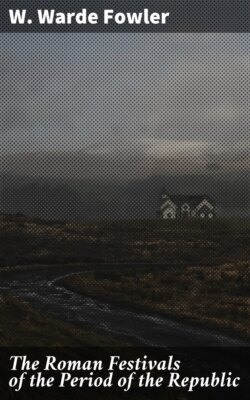Читать книгу The Roman Festivals of the Period of the Republic - W. Warde Fowler - Страница 8
На сайте Литреса книга снята с продажи.
IV. The Days.
ОглавлениеTable of Contents
Every day in the Roman calendar has a certain mark attached to it, viz. the letters F, C, N, NP, EN, Q.R.C.F., Q.St.D.F., or FP. All of these have a religious significance, positive or negative.
F, i.e. fas or fastus, means that on the day so marked civil and especially judicial business might be transacted without fear of divine displeasure[18]. Correctness in the time as well as place of all human actions was in the mind of the early Roman of the most vital importance; and the floating traditional ideas which governed his life before the formation of the State were systematized and kept secret by kings and priests, as a part, so to speak, of the science of government. Not till B.C. 304 was the calendar published, with its permissive and prohibitive regulations[19].
C (comitialis) means that the day so marked was one on which the comitia might meet[20], and on which also legal business might be transacted, as on the days marked F, if there were no other hindrance. The total number of days thus available for secular business, i.e. days marked F and C, was in the Julian calendar 239 out of 365.
N, i.e. nefastus, meant that the day so marked was religiosus, vitiosus, or ater; as Gellius has it[21], ‘tristi omine et infames impeditique, in quibus et res divinas facere et rem quampiam novam exordiri temperandum est.’ Some of these days received the mark in historical times for a special reason, e.g. a disaster to the State; among these were the postriduani or days following the Kalends, Nones and Ides, because two terrible defeats had occurred on such days[22]. But most of them (in all they are 57) were probably so marked as being devoted to lustrations, or worship of the dead or of the powers of the earth, and therefore unsuitable for worldly business. One long series of such dies nefasti occurs Feb. 1–14, the time of purification; another, April 5–22, in the month occupied by the rites of deities of growing vegetation; a third, June 5–14, when the rites of the Vestals preparatory to harvest were taking place; and a fourth, July 1–9, for reasons which are unfortunately by no means clear to us.
NP was not a mark in the pre-Julian calendars, for it was apparently unknown to Varro and Ovid. Verrius Flaccus seems to have distinguished it from N, but his explanation is mutilated, even as it survives in Festus[23]. No one has yet determined for certain the origin of the sign, and discussion of the various conjectures would be here superfluous[24]. It appears to distinguish, in the Julian calendars, those days on which fell the festivals of deities who were not of an earthly and therefore doubtful character from those marked N. Thus in the series of dies nefasti in February and April the Ides in each case have the mark NP as being sacred to Jupiter.
EN. We have a mutilated note in the calendar of Praeneste which indicates what this abbreviation meant, viz. endotercisus = intercisus, i.e. ‘cut into parts’[25]. In morning and evening, as Varro tells us, the day was nefastus, but in the middle, between the slaying of the victim and the placing of the entrails upon the altar, it was fastus. But why eight days in the calendar were thus marked we do not know, and have no data for conjecturing. All the eight were days coming before some festival, or before the Ides. Of the eight two occur in January and two in February, the others in March, August, October and December. But on such facts no conjectures can be built.
Q.R.C.F. (Quando Rex Comitiavit Fas) will be explained under March 24; the only other day on which it occurs is May 24. Q.St.D.F. (Quando stercus delatum fas) only occurs on June 15, and will there be fully dealt with.
FP occurs thrice, but only in three calendars. Feb. 21 (Feralia) is thus marked in Caer.[26], but is F in Maff. April 23 (Vinalia) is FP in Caer. but NP in Maff. and F in Praen. Aug. 19 (Vinalia rustica) is FP in Maff. and Amit, F in Antiat. and Allif., NP in Vall. Mommsen explains FP as fastus principio, i.e. the early part of the day was fastus, and suggests that in the case of the Feralia, as the rites of the dead were performed at night, there was no reason why the earlier part of the day should be nefastus. But in the case of the two Vinalia we can hardly even guess at the meaning of the mark, and it does not seem to have been known to the Romans themselves.
